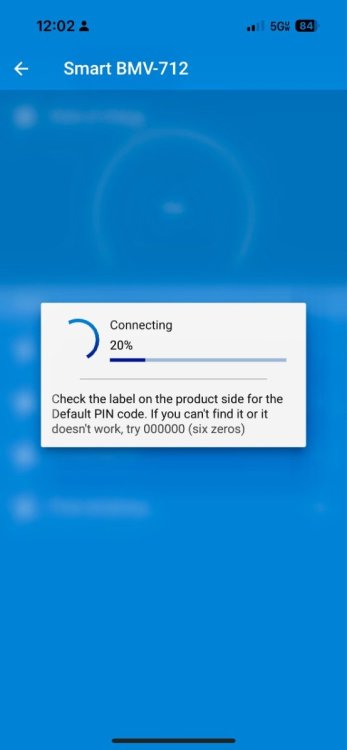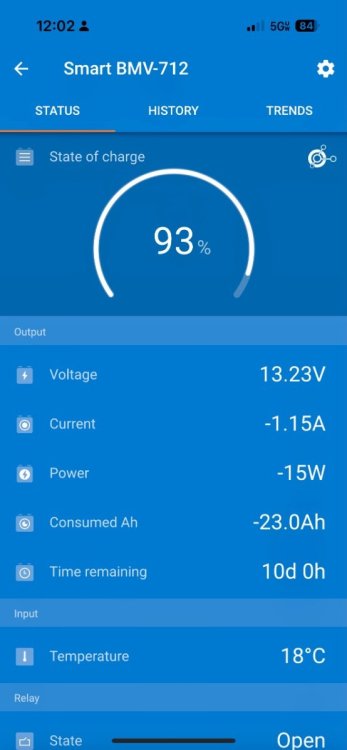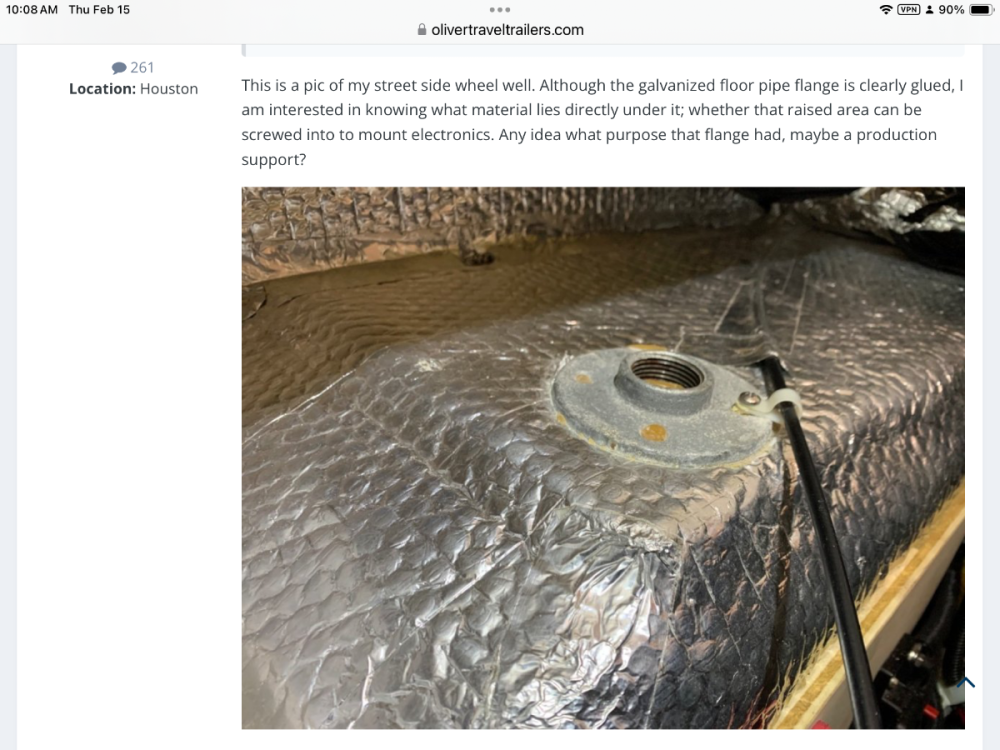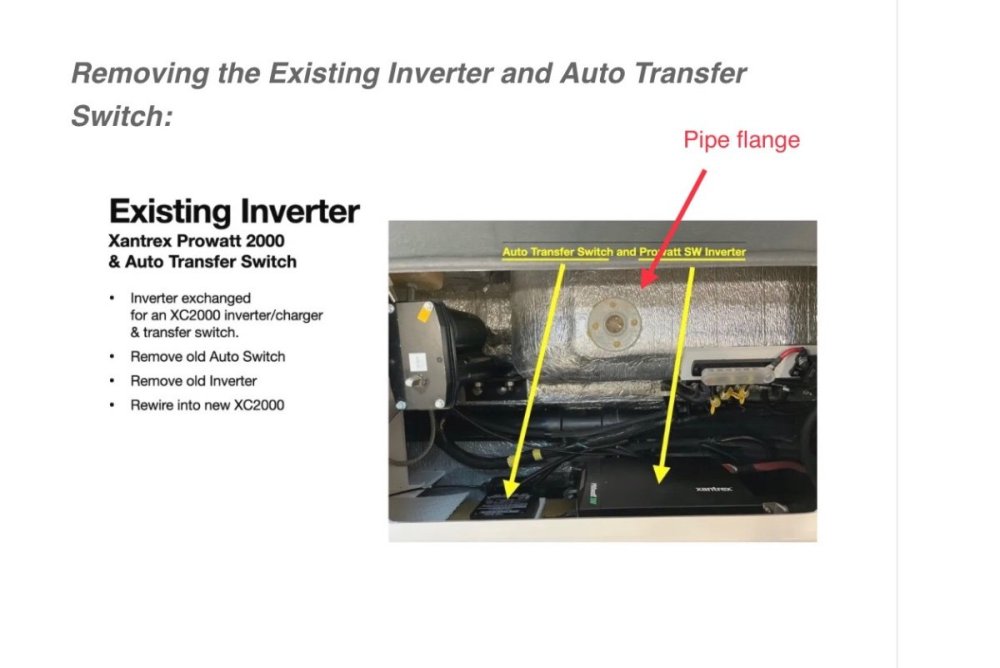-
Posts
1,719 -
Joined
-
Last visited
-
Days Won
41
Posts posted by mossemi
-
-
16 minutes ago, Geronimo John said:
From the Victron 712 Smart manual, below are the connections. I assume that the VE.Direct (Terminal I) is where I could plug in the dongle which appears to also have a 4 wire flat "VE Direct" connector.
That is correct, but you will end up with 2 Instances of the 712 on The Victron Connect app.
Are you having trouble receiving Bluetooth signals from your 712? I thought it was from your DC-DC charger, which doesn’t have a VE.Direct port to my knowledge. Victron did add a VE.Direct port to their newest DC-DC charger.
I have seen references to the Smart Dongle and the Smart Shunt connected together, but I don’t have either product, so no first hand experience. All of the Victron devices that I have that also have a VE.Direct port, have male pins. Does the Smart Dongle have a male or female VE.Direct connector? -
-
 1
1
-
-
i have also inadvertently opened my rear propane quick connect valve by accident, but I just emptied the tank. Never smelled anything. But I am not smart enough to say it’s a bad design. After all, this is my first and only travel trailer. I chalked it up as user error and moved on. But your recent issue caused me to rethink the issue and I think I’m going to try putting a quick connect plug together and see if it would stop a leak with the valve partially open.
Has anyone else done this?
Mossey
-
 1
1
-
 2
2
-
-
What's a BLuetooth Radio?
My bad! Poor choice of words. I consider any device that can receive, transmit or both an RF signal, a radio. Let’s use a cellular phone as an example. Smart cellphone's have several "radio's" inside of them. First is the cellular radio which is actually a transceiver, meaning it can transmit and receive RF/radio frequency signals. Second is the GPS radio which can receive satellite signals and provide location service when you are out of cellular service. The phone also has an A-GPS which is Assisted GPS which receives GPS data from the cellular network and combines it with the satellite data. A-GPS works better indoors where satellite signal are weaker. The third is the WiFi radio which is also a transceiver. The fourth radio is the Bluetooth radio which is a transmitter.
Were you using a dongle or just the 712 Smart (Shunt and Display Combo)?
I am using a BMV-712.
If not using a dongle, does the 712 Smart System broadcast the Bluetooth "signal" from the shunt or the display?
From the display.
I believe part of the inherent Bluetooth transmit problem with the Smart Shunt is the placement of the Bluetooth transmitter which is stuck onto the shunt itself. It will never transmit an omnidirectional signal so it is probably possible to increase its transmitter range by changing its orientation. The same thought would also apply to the Smart Dongle which I believe is also directional by design.
Mossey
-
 1
1
-
 3
3
-
-
5 hours ago, MAX Burner said:
@mossemi - Just wondering... Are you able to monitor your Victron charging data while towing with your current configuration?
Good question! I don’t know, never tried, but I will just for you😎 and let you know.
I did a simulated hookup by backing my F150 up to the Bulldog and did a test. I had no problem connecting to my Victron BMV-712 which has its own Bluetooth radio in the display and is installed under the SS bed. These 2 pictures show the BMV-712 Bluetooth off and on.
Mossey
Bluetooth off while I was in Ollie.
Bluetooth on while I was in my truck.
-
 1
1
-
 2
2
-
-
3 hours ago, Geronimo John said:
Again, mostly for others use......
It's the same with my battery jump box. Sharing is caring!
Mossey
-
 5
5
-
 1
1
-
-
1 hour ago, topgun2 said:
Sure is a bunch less expensive than the Viair too.
Since that price is for the bare tool only, I doubt it's a bunch cheaper. Since I'm not an old Milwaukee guy, just a Milwaukee guy and do not own an DeWalt tools, I did buy a Viair several years back. And the only time I needed it was to help a neighboring camper air up his bicycle tires.
Mossey


-
 1
1
-
 1
1
-
-
8 hours ago, HDRider said:
Does anyone here use Roadpass?
I have been a Campendium user for several years. Last year they changed their membership policy and I added Roadtripper to my account. Roadtripper is a trip planning app. Roadpass is the key to enter into their premium membership program features. I use Campendium to find campgrounds and Roadtripper to plan my route and find things of interest along the way.
Is it worth the money? I try not to help people spend their money so I won’t say, but I will renew my membership next month. After all, someone has to stimulate the economy.
Mossey
-
 1
1
-
 1
1
-
 1
1
-
 2
2
-
-
-
 4
4
-
-
56 minutes ago, Geronimo John said:
For the Bathroom cubby it would be a waste of fender washers as they are not high load or vibration applications.
I replaced the vanity towel bar/access cover with a marine hatch as several others have done. I used screws and nylon insert lock nuts to mount my hatch. If you follow @Frank C's installation and reuse the original vanity towel bar/access cover, I don't think you can beat his use of U nuts. I wish he had completed his version before I did mine, because I prefer his method!
Mossey
-
 3
3
-
-
2 hours ago, Geronimo John said:
The below does not apply to this install.
I thought you and rich.dev were discussing plusnuts installed in fiberglass.
Mossemi
-
 1
1
-
-
13 hours ago, Geronimo John said:
Per your reference, I checked Splendiday.com and order out a set of them. Their design uses four "Petals" vs. most others that have just three. I like that.
I experimented with these on a scrape of OTT fiberglass for a mod I had in mind. I used a long bolt a couple of nuts and a pair of wrenches to crush them. I believe they are a worthy product for an anchor/mounting point in or outside of an Ollie. I still haven’t completed it, but it’s still on the list
Mossey
-
 4
4
-
-
12 hours ago, Dennis and Melissa said:
If I'm thinking clearly, it will allow me external surge protection for both 50 and 30 amp hookups.
That is correct!
Mossey
-
 1
1
-
-
On 1/27/2024 at 11:49 AM, jd1923 said:
@Ronbrink Unless you purchased yours new, somebody must have added that galvanized threaded pipe mount! I can't imagine a purpose for such a large ugly mount in that location.
I was reading Galway Girl's Blog about their DC System upgrade and found another pipe flange installed on the interior top of the SS wheel well. I still don’t know why it’s there, unless I have missed someone’s response to that question, but Ronbrink's is not a 1 of mystery.
Mossey
@Ronbrink's picture
@Galway Girl's picture
-
 1
1
-
-
On 2/5/2024 at 8:27 AM, mossemi said:
I'm adding rear axle and cargo/payload number to my original reply!
Rear axle = 3.55
Cargo/payload = 1637 lbs.
Mossey
-
 2
2
-
-
15 minutes ago, Steve Lovaas said:
Anyone have a feline presence in their Ollie?
Are you going to be first to post a picture of a feline traveling companion?
Mossey
-
2 hours ago, topgun2 said:
That amazed me - where in the world does all that string go?
Are you sure you didn’t use some for backing on your fly reel?
Mossey
-
 1
1
-
 3
3
-
-
4 hours ago, GAP said:
Very kind of you all. I feel attached to this community so would be appreciate of lurking around the edges.
Congratulations! Sounds like you found an RV that is more suitable to your camping style. We are looking forward to your reports of some of your new camping adventures. And please remember that you are always welcome to join us!
Mossey
-
 1
1
-
 6
6
-
-
4 hours ago, shhQuiet said:
This is my old girl Oreo, my constant companion:
She looks comfortable. Is she a toy or a miniature?
Mossey
-
-
-
@Mark and Lorraine I find the variety of solutions among Ollie owners to the same need or issue, to be truly amazing! Very nice mod.
Mossey
-
 2
2
-
-
Very nice mod with a simple approach and excellent results! Thanks for sharing.
Mossey
-
 1
1
-
 2
2
-
-
9 hours ago, jd1923 said:
I'm still at loss in name of the manufacture, let alone a part number
I sometimes find hard to locate items on the web by using a picture search on the Google search engine.
Mossey
-
 1
1
-
 3
3
-













Propane Smell in Trailer
in Mechanical & Technical Tips
Posted
I never thought of the rubber plug as leak prevention, just keeping the fitting clean. But what do I know?
Mossey